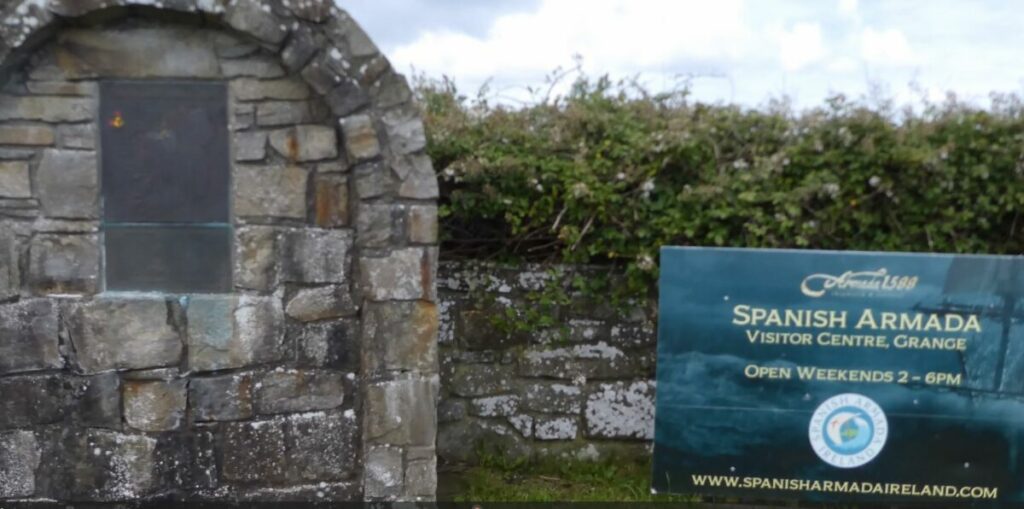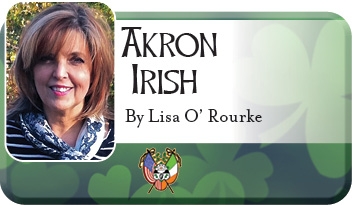

By Lisa O’Rourke
It seems unnecessary to state that a person wandering alone naked was also afraid. The terms seem synonymous unless you happen to be Madonna.
Yet reading the sixteenth century letter written by Captain Francisco de Cuellar in 1591, those two words combine with cold and starving to tell an Irish survivor story that is horrifying. How did a Spanish Armada captain find himself in Ireland and in this kind of trouble?
These questions arose from a recent trip to Sligo. My brother-in-law, in his capacity as tour guide extraordinaire, took us to Streedagh Beach in Grange. The beach is on a peculiar little isthmus, with views of the green, flat-topped Benbulben to one side and the hills of Donegal on the other, with teal water and white beach in between. Just beautiful.
Down the beach, a white flag with a red cross fluttered in the breeze. It sits in the middle of a facsimile of a ship prow and is a memorial to an Armada shipwreck.
The coastline was far from beautiful on the evening of September 25, 1588. That evening, three damaged ships, fresh from battle, found themselves floundering off the Sligo coast. They were in retreat from a skirmish with Queen Elizabeth’s English Navy. The Armada had attempted a surprise attack on the English Navy, ending up the worse for their efforts.
The English blocked the channel, so the only retreat for the Spanish, despite difficulty and length, was for the ships to go up around the northern tip of Scotland and then down along the western edge of Ireland, hoping to make it into the open Atlantic and back to Spain.
That September evening, the ships met with bad weather and the tricky water off the Sligo coast. A thousand sailors drowned in the water. How sailors would sail and not be able to swim or be silly enough to try to with gold doubloons stitched into their clothes is nothing short of amazing.

The few who made it to shore quickly found out that they were far from safe. They were met by English soldiers intent on murdering them on the spot. The soldiers were embedded thanks to the already active English gentry presence in Ireland. The soldiers did not manage to slay every sailor who crawled ashore.
According to the letter writing survivor, Captain Francisco de Cuellar, those that lived were next set upon by savages. Yes, he was calling the Irish people savages. He continued that perception for the seven months that he travelled around Ireland, wait for it, naked and afraid.
Captain de Cuellar seemed to encounter more mild brutality than kindness in his wander around Ireland. He blundered around, randomly struck and stripped of everything he owned or accumulated. He was wounded and hiding from the English who were still looking for survivors.
He never mentions that anything has any beauty to him but for a few women. Maybe that was a thing then. He continues, hiding from almost everyone, barely clinging to life, until he meets a friendly old woman, who instructs him to go over the hills and find O’Rourke. O’Rourke was no friend of the English and would certainly help him.
How could I resist this? History seduces us by offering a brave and flattering version of our ancestors, letting us reflect that glow. I had to know this story, especially since some old dots were connecting, but more about that later.
Indeed, de Cuellar followed that advice and a trail marked “de Cuellar Way” is visible from the road and marks the presumed walk he took between Sligo and Leitrim. The walk winds through the hills around beautiful Glencar Falls and the side of Benbulben. From there, de Cuellar arrived in what was then Breifne, clan homeland of the O’Rourke chieftains.

And it is there that de Cuellar is finally given the hospitality that the Irish reputation promises. He is given some blankets and rough clothing. He is fed, although the food; chiefly butter, oaty bread and milk (some things never change), was not to his taste.
Most importantly to him, he also met other Spanish sailors who had been sheltered by the Chieftain, Brian O’Rourke. I suddenly knew how this story ended for Brian.
Several dozen years ago, an O’Rourke auntie and nun was transferred to London for a few years. Being the family historian, her curiosity led her to the Tower of London. She found herself standing in front of the Tower warden Beefeater asking if she could research her ancestor, Brian O’Rourke, known as Brian of the Ramparts.
She knew that he had been a prisoner in the Tower. She also knew that he was hung, drawn, and quartered in London of 1591, a nasty death. His crime was treason.
Was it treason to give shelter to human beings whose existence depended on finding some bit of kindness? Yes, it was if you know anything at all about Queen Lizzie. She took no prisoners, as the saying goes.
Well, at least I had the comfort of knowing that our ancestor, Brian, was brave and kind. I had that comfort for a day or two. Curiosity led me to research the O’Rourke chieftains of that era.
Apparently “Game of Thrones” style morality was the way to hold power at that time. No one person or family had any worries about killing pesky relations that threatened them. It was the cost of leadership.
It had stuck with me that Auntie Maureen, in talking about her research, commented over and over again after her visits, how kind the English soldiers at the Tower always were to her. After all, on some level, she was a symbol of O’Rourke and his clan and, alternatively, they were a symbol of a long dead queen. Instead, they all chose to live in the moment, realizing the puzzle of the past was far beyond them.
Even the history written by de Cuellar may have been skewed to illustrate a penance paid for abandoning the fight and retreating from the English Channel. Our eyes cannot see that far behind us, but they can navigate a road ahead.
Find this column and others from the October 2023 issue here!

*Lisa O’Rourke is an educator from Akron. She has a BA in English and a Master’s in Reading/Elementary Education.Lisa is a student of everything Irish, primarily Gaeilge. She runs a Gaeilge study group at the AOH/Mark Heffernan Division.She is married to Dónal and has two sons, Danny and Liam. Lisa enjoys art, reading, music, and travel. She enjoys spending time with her dog, cats and fish. Lisa can be contacted at [email protected].
Please Send Akron area events to my email so we can share them with our readers!





Monthly newsmagazine serving people of Irish descent from Cleveland to Clearwater. We cover the movers, shakers & music makers each and every month.
Since our 2006 inception, iIrish has donated more than $376,000 to local and national charities.
GET UPDATES ON THE SERIOUS & THE SHENANIGANS!